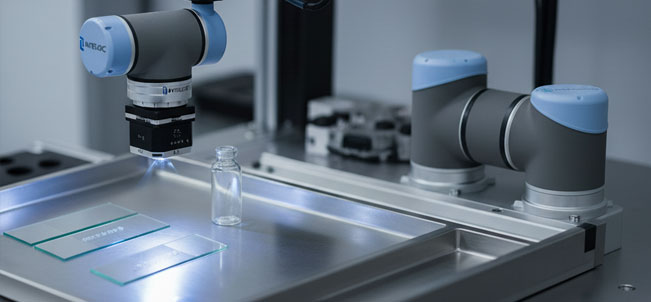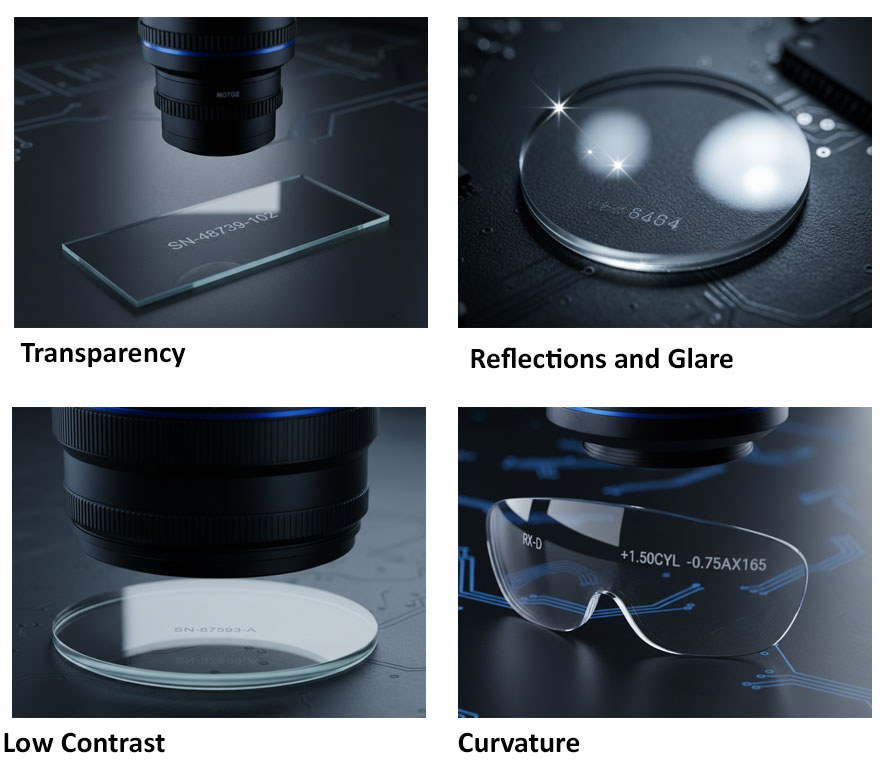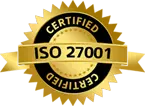Introduction
In optical and medical device manufacturing, reading text or serial numbers from glass surfaces — such as lenses, prisms, optical filters, or transparent covers — is a significant challenge. The marks are often extremely small, shallow, or faint, written by laser etching, micro-printing, or inkjet on a highly reflective or transparent surface.
Conventional OCR systems struggle with such surfaces due to low contrast, reflection, and refraction. However, Intelgic’s AI-powered OCR technology has been engineered specifically to overcome these challenges — accurately reading small and micro texts on glass and other transparent materials with unmatched precision.

Why Reading Text on Glass is Difficult
Glass presents a unique set of optical challenges that make text detection and reading far more complex than on opaque materials:
Transparency
Unlike metal or plastic, glass does not reflect enough visible light from its surface for typical camera sensors to detect markings clearly.
Reflections and Glare
Surrounding light sources and lenses cause specular reflections, which mask engraved or printed text.
Low Contrast
Micro laser-engraved or etched text appears only as a faint variation in refractive index — almost invisible in standard imaging.
Curvature
Many glass components, like spectacle lenses or optical domes, are curved. This distorts the shape and alignment of text.
Tiny Font Size
Markings can be less than 0.1 mm in height, requiring ultra-high-resolution imaging and precision optics.

Intelgic’s OCR AI system is designed from the ground up to address each of these issues using a combination of specialized imaging hardware and deep-learning-based OCR algorithms.
Intelgic OCR AI: Built for Transparent and Reflective Surfaces
Intelgic's OCR and Text Reading AI system combines advanced imaging science with AI-driven recognition models that are specifically tuned for transparent and reflective materials like glass.
Core Capabilities
- Reads laser-etched, micro-printed, or engraved text on glass or lens surfaces.
- Detects text, symbols, and alphanumeric codes as small as 50 microns in height.
- Works on transparent, semi-transparent, or coated glass.
- Compensates for curvature, angle, and reflection variations.
- Supports multi-language OCR, including English, Chinese, Japanese, and others.
- Delivers real-time recognition for inline inspection and laboratory verification.
The Imaging Principle Behind the Solution
Intelgic's OCR for glass relies on controlled illumination geometry and high-resolution imaging to enhance the contrast between the glass surface and the marking.
1. Coaxial and Dark-Field Illumination
- Coaxial light (top-down illumination through beam splitters) is used to minimize reflection from the curved glass.
- Dark-field or low-angle lighting highlights tiny laser etchings that would otherwise be invisible.
2. Polarization and Filter Control
- Cross-polarized filters eliminate specular glare.
- Narrow-band filters isolate reflections from specific wavelengths to enhance etched patterns.
3. Optical Setup
- Telecentric or macro lenses capture distortion-free images.
- Auto-focus and adaptive exposure ensure clarity across varying thicknesses or curvature of glass.
- For microscopic text, microscope-grade imaging modules or macro-zoom cameras (up to 65 MP) are used.
AI-Based OCR and Text Recognition Workflow
Once the image is captured under optimal lighting, Intelgic’s OCR AI engine performs the following steps:
1. Preprocessing
The system enhances micro-contrast, removes glare, and normalizes brightness using AI-driven image conditioning filters.
2. Text Region Detection
Using deep learning, the system identifies the location of microtext even if it is curved, rotated, or partially visible.
3. Character Recognition
OCR models trained on microscopic fonts and laser-engraved markings decode letters, numbers, and symbols with pixel-level accuracy.
4. Post-Processing & Validation
> The extracted text is validated using pattern matching or checksum logic and can be compared with a master database for verification.
5. Data Integration
The recognized data is automatically logged or transferred to ERP, MES, or cloud systems via REST APIs or OPC UA connections.
Applications
Intelgic's OCR for glass surfaces is used across multiple industries where traceability, branding, or regulatory labeling is required on optical or transparent components.
| Industry | Use Case |
|---|---|
| Optical & Lens Manufacturing | Reading laser-marked serial numbers and product IDs on spectacle lenses, contact lenses, and optical filters. |
| Medical Devices | Reading tiny engraved identifiers on transparent medical implants or surgical lenses. |
| Semiconductor & Display | Reading printed or laser-marked characters on wafers, glass substrates, and optical films. |
| Packaging & Pharmaceuticals | Reading micro laser codes on transparent vials, bottles, or ampoules for traceability. |
| Automotive | Reading etched text or logos on windshields, mirrors, and headlamp lenses. |
Key Benefits of Intelgic's OCR AI for Glass
Reads invisible markings
Detects and interprets microtext invisible to the human eye under normal lighting.
Works on curved and polished surfaces
Specialized optics and AI algorithms correct for curvature and reflection.
Non-contact and fast
Ideal for both static and dynamic imaging setups.
High accuracy
>99% reliable recognition rate in industrial environments.
Integration-ready
Works with existing vision systems, PLCs, and Intelgic’s Live Vision AI dashboard.
Traceability enabled
Generates Digital Quality Certificates (DQC) and records every read with image and timestamp.
Example Use Case: Lens Serial Number Verification
- Standalone OCR Station: Desktop setup with high-resolution camera and lighting module
- Inline Inspection System: Integrated on conveyor or robotic arm for automated optical inspection.
- Mobile OCR Option: Handheld or mobile app connected to Intelgic Cloud for field or lab use.
- Cloud Reporting: Real-time inspection data, analytics, and images stored in Intelgic’s secure cloud dashboard.
In optical lens manufacturing, each lens often carries a microscopic laser-engraved serial number to ensure traceability and authenticity.
Intelgic’s OCR AI captures these marks through macro-imaging optics with cross-polarized lighting, then processes them with neural OCR models trained specifically for etched glass markings.
The extracted text is instantly compared with the production database, validating the part’s identity before packaging.
This automation eliminates manual verification, prevents mix-ups, and creates a digital record of every inspected lens — essential for both quality assurance and regulatory compliance.
Integration and Automation Options
Reading microtext and laser markings on glass is one of the most complex challenges in industrial vision — but Intelgic’s OCR & Text Reading AI makes it practical, accurate, and fast.
By combining precision imaging, adaptive lighting control, and deep learning-based OCR, Intelgic enables manufacturers to achieve true traceability on transparent materials like lenses and glass components.
From spectacle lenses to optical wafers, Intelgic’s OCR solution transforms nearly invisible markings into reliable, verifiable data, empowering industries to move closer to zero-defect, fully traceable manufacturing.


